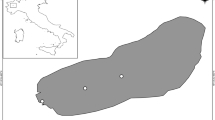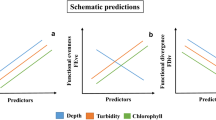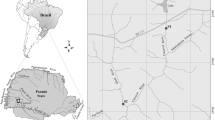Abstract
Accelerated eutrophication reduces water quality and shifts plankton communities. However, its effects on the aquatic food web and ecosystem functions remain poorly understood. Within this context, functional ecology can provide valuable links relating community traits to ecosystem functioning. In this study, we assessed the effects of eutrophication and cyanobacteria blooms on zooplankton functional diversity in a tropical hypereutrophic lake. Phytoplankton and zooplankton communities and limnological characteristics of a tropical Brazilian Lake (Southeast, Brazil) were monitored monthly from April 2013 to October 2014. Lake eutrophication indicators were total phosphorus, total chlorophyll-a, and chlorophyll-a per group (blue, green, and brown). The variation of major phytoplankton taxonomic group biomass was calculated and used as a proxy for changes in phytoplankton composition. Zooplankton functional diversity was assessed through functional dispersion and the community-weighted mean trait value. Regressions were performed between the lake eutrophication indicators, the phytoplankton biomass variation, and zooplankton functional dispersion. Our results suggest that eutrophication and cyanobacterial dominance change the composition of zooplankton traits and reduce functional dispersion, leading to zooplankton niche overlap. These findings are important because they provide a meaningful view of phytoplankton-zooplankton trophic interactions and contribute to an improved understanding their functional effects on aquatic ecosystems.




Similar content being viewed by others
References
Ahlgren, G., I. B. Gustafsson & M. Boberg, 1992. Fatty acid content and chemical composition of freshwater microalgae. Journal of Phycology 28: 37–50.
Alvares, C. A., J. L. Stape, P. C. Sentelhas, G. de Moraes, J. Leonardo & G. Sparovek, 2014. Köppen's climate classification map for Brazil. Meteorologische Zeitschrift 22: 711–728.
Arndt, H., 1993. Rotifers as predators on components of the microbial web (bacteria, heterotrophic flagellates, ciliates)—a review. Hydrobiologia 255: 231–246.
Barnett, A. & B. E. Beisner, 2007. Zooplankton biodiversity and lake trophic state: Explanations invoking resource abundance and distribution. Ecology 88: 1675–1686.
Bec, A., D. Martin-Creuzburg & E. von Elert, 2006. Trophic upgrading of autotrophic picoplankton by the heterotrophic nanoflagellate Paraphysomonas sp. Limnology and Oceanography 51: 1699–1707.
Bini, L. M., V. L. Landeiro, A. A. Padial, T. Siqueira & J. Heino, 2014. Nutrient enrichment is related to two facets of beta diversity for stream invertebrates across the United States. Ecology 95: 1569–1578.
Bouvy, M., M. Pagano & M. Troussellier, 2001. Effects of a cyanobacterial bloom (Cylindrospermopsis raciborskii) on bacteria and zooplankton communities in Ingazeira reservoir (northeast Brazil). Aquatic Microbial Ecology 25: 215–227.
Boyero, L., M. A. G. Tonin, J. Pérez, A. Swafford, V. Ferreira, A. Landeira-Dabarca, M. Alexandrou, M. O. Gessner, B. G. McKie & R. J. Albariño, 2017. Riparian plant litter quality increases with latitude. Scientific Reports 7: 10562.
Brett, M. T. & D. C. Müller-Navarra, 1997. The role of highly unsaturated fatty acids in aquatic food web processes. Freshwater Biology 38: 483–499.
Brett, M. T., M. J. Kainz, S. J. Taipale & H. Seshan, 2009. Phytoplankton, not allochthonous carbon, sustains herbivorous zooplankton production. Proceedings of the National Academy of Sciences 106: 21197–21201.
Carpenter, S. R. & J. F. Kitchell, 1996. The trophic cascade in lakes. Cambridge University Press, England.
Carpenter, S. R., J. F. Kitchell & J. R. Hodgson, 1985. Cascading trophic interactions and lake productivity. BioScience 35: 634–639.
Chapin III, F. S., E. S. Zavaleta, V. T. Eviner, R. L. Naylor, P. M. Vitousek, H. L. Reynolds, D. U. Hooper, S. Lavorel, O. E. Sala, S. E. Hobbie & M. C. Mack, 2000. Consequences of changing biodiversity. Nature 405: 234–242.
Chase, J. M., 2010. Stochastic community assembly causes higher biodiversity in more productive environments. Science 328: 1388–1391.
Cotner, J. B. & B. A. Biddanda, 2002. Small players, large role: microbial influence on biogeochemical processes in pelagic aquatic ecosystems. Ecosystems 5: 105–121.
DeMott, W. R., 1986. The role of taste in food selection by freshwater zooplankton. Oecologia 69: 334–340.
DeMott, W. R. & F. Moxter, 1991. Foraging cyanobacteria by copepods: Responses to chemical defense and resource abundance. Ecology 72: 1820–1834.
DeMott, W. R., Q. X. Zhang & W. W. Carmichael, 1991. Effects of toxic cyanobacteria and purified toxins on the survival and feeding of a copepod and three species of Daphnia. Limnology and Oceanography 36: 1346–1357.
DeMott, W. R., R. D. Gulati & E. Van Donk, 2001. Daphnia food limitation in three hypereutrophic Dutch lakes: evidence for exclusion of large-bodied species by interfering filaments of cyanobacteria. Limnology and Oceanography 46: 2054–2060.
Díaz, S. & M. Cabido, 2001. Vive la différence: Plant functional diversity matters to ecosystem processes. Trends in Ecology and Evolution 16: 646–655.
Dumont, H. J., I. Van De Velde & S. Dumont, 1975. The dry weight estimate of biomass in a selection of Cladocera, Copepoda, and Rotifera from the plankton, periphyton, and benthos of continental waters. Oecologia 19: 75–97.
Engström-Öst, J., A. Brutemark, A. Vehmaa, N. H. Motwani & T. Katajisto, 2015. Consequences of a cyanobacteria bloom for copepod reproduction, mortality and sex ratio. Journal of Plankton Research 37: 388–398.
Ersoy, Z., E. Jeppesen, S. Sgarzi, I. Arranz, M. Cañedo-Argüelles, X. D. Quintana, F. Landkildehus, T. L. Lauridsen, M. Bartrons & S. Brucet, 2017. Size-based interactions and trophic transfer efficiency are modified by fish predation and cyanobacteria blooms in Lake Mývatn, Iceland. Freshwater Biology 62: 1942–1952.
Figueredo, C. C., R. M. Pinto-Coelho, A. M. M. Lopes, P. H. Lima, B. Gücker & A. Giani, 2016. From intermittent to persistent cyanobacterial blooms: Identifying the main drivers in an urban tropical reservoir. Journal of Limnology 75: 445–454.
Gasol, J. M. & C. M. Duarte, 2000. Comparative analyses in aquatic microbial ecology: How far do they go? FEMS Microbiology Ecology 31: 99–106.
Ger, K. A., R. Panosso & M. Lürling, 2011. Consequences of acclimation to Microcystis on the selective feeding behavior of the calanoid copepod Eudiaptomus gracilis. Limnology and Oceanography 56: 2103–2114.
Ger, K. A., P. Urrutia-Cordero, P. C. Frost, L. A. Hansson, O. Sarnelle, A. E. Wilson & M. Lürling, 2016. The interaction between cyanobacteria and zooplankton in a more eutrophic world. Harmful Algae 54: 128–144.
Ghadouani, A., B. Pinel-Alloul & E. E. Prepas, 2003. Effects of experimentally induced cyanobacterial blooms on crustacean zooplankton communities. Freshwater Biology 48: 363–381.
Hairston Jr., N. G., C. L. Holtmeier, W. Lampert, L. J. Weider, D. M. Post, J. M. Fischer, C. E. Caceres, J. A. Fox & U. Gaedke, 2001. Natural selection for grazer resistance to toxic cyanobacteria: Evolution of phenotypic plasticity? Evolution 55: 2203–2214.
Hansson, L. A., S. Gustafsson, K. Rengefors & L. Bomark, 2007. Cyanobacterial chemical warfare affects zooplankton community composition. Freshwater Biology 52: 1290–1301.
Harrison, S., M. Vellend & E. I. Damschen, 2011. ‘Structured’beta diversity increases with climatic productivity in a classic dataset. Ecosphere 2: 1–13.
Heathcote, A. J., C. T. Filstrup, D. Kendall & J. A. Downing, 2016. Biomass pyramids in lake plankton: Influence of Cyanobacteria size and abundance. Inland Waters 6: 250–257.
Hébert, M. P., B. E. Beisner & R. Maranger, 2016. A meta-analysis of zooplankton functional traits influencing ecosystem function. Ecology 97: 1069–1080.
Hébert, M. P., B. E. Beisner & R. Maranger, 2017. Linking zooplankton communities to ecosystem functioning: Toward an effect-trait framework. Journal of Plankton Research 39: 3–12.
Hillebrand, H., C. D. Durselen, D. Kirschtel, U. Pollingher & T. Zohary, 1999. Biovolume calculation for pelagic and benthic microalgae. Journal of Phycology 35: 403–424.
Hooper, D. U., F. S. Chapin, J. J. Ewel, A. Hector, P. Inchausti, S. H. Lavorel, J. Lawton, D. M. Lodge, M. Loreau, S. Naeem, B. Schmid, H. Setälä, A. J. Symstad, J. Vandermeer & D. A. Wardle, 2005. Effects of biodiversity on ecosystem functioning: A consensus of current knowledge. Ecological Monographs 75: 3–35.
Kassen, R., A. Buckling, G. Bell & P. B. Rainey, 2000. Diversity peaks at intermediate productivity in a laboratory microcosm. Nature 406: 508–512.
Kiørboe, T., 2011. How zooplankton feed: Mechanisms, traits, and trade-offs. Biological Reviews 86: 311–339.
Komárek, J. & K. Anagnostidis, 1998. Cyanoprokaryota. 1. Teil Chroococcales. In Ettl, H., G. Gärtner, H. Heynig & D. Möllenhauer (eds), Sübwasserflora von Mitteleuropa. Gustav Fischer Verlag, Stuttgart: 1–548.
Komárek, J. & K. Anagnostidis, 2005. Cyanoprokaryota. 2. Teil Oscillatoriales. In: B. Büdel, L. Krienitz, G. Gärtner & M. Schagerl (eds). Sübwasserflora von Mitteleuropa. Elsevier: Spektrum Akademischer Verlag, Munique.
Kosiba, J., W. Krztoń & E. Wilk-Woźniak, 2018. Effect of microcystins on proto-and metazooplankton is more evident in artificial than in natural waterbodies. Microbial Ecology 75: 293–302.
Laliberté, E., P. Legendre & B. Shipley, 2014. FD: measuring functional diversity from multiple traits, and other tools for functional ecology. R package version 1.0-12
Laliberté, E. & P. Legendre, 2010. A distance-based framework for measuring functional diversity from multiple traits. Ecology 91: 299–305.
Litchman, E., M. D. Ohman & T. Kiørboe, 2013. Trait-based approaches to zooplankton communities. Journal of Plankton Research 35: 473–484.
Lund, J. W. H., C. Kipling & E. D. Cren, 1958. The inverted microscope method of estimating algal number and statistical basis of estimating by counting. Hydrobiologia 11: 143–170.
Lürling, M., 2003. Daphnia growth on microcystin-producing and microcystin-free Microcystis aeruginosa in different mixtures with the green alga Scenedesmus obliquus. Limnology and Oceanography 48: 2214–2220.
MacArthur, R. H., 1970. Species packing and competitive equilibria for many species. Theoretical Population Biology 1: 1–11.
Miranda, M., N. Noyma, F. S. Pacheco, L. de Magalhães, E. Pinto, S. Santos, M. F. A. Soares, V. L. Huszar, M. Lürling & M. M. Marinho, 2017. The efficiency of combined coagulant and ballast to remove harmful cyanobacterial blooms in a tropical shallow system. Harmful Algae 65: 27–39.
Moss, B., S. Kosten, M. Meerhoff, R. W. Battarbee, E. Jeppesen, N. Mazzeo, K. Havens, G. Lacerot, Z. Liu, L. De Meester & H. Paerl, 2011. Allied attack: Climate change and eutrophication. Inland Waters 1: 101–105.
Müller-Navarra, D. C., M. T. Brett, A. M. Liston & C. R. Goldman, 2000. A highly unsaturated fatty acid predicts carbon transfer between primary producers and consumers. Nature 403: 74–77.
Obertegger, U., H. A. Smith, G. Flaim & R. L. Wallace. 2011. Using the guild ratio to characterize pelagicrotifer communities. Hydrobiologia 662: 157–162.
Paerl, H. W. & J. Huisman, 2009. Climate change: A catalyst for global expansion of harmful cyanobacterial blooms. Environmental Microbiology Reports 1: 27–37.
Paerl, H. W. & V. J. Paul, 2012. Climate change: Links to global expansion of harmful cyanobacteria. Water Research 46: 1349–1363.
Paerl, H. W., R. S. Fulton, P. H. Moisander & J. Dyble, 2001. Harmful freshwater algal blooms, with an emphasis on cyanobacteria. The Scientific World Journal 1: 76–113.
Panosso, R., P. E. R. Carlsson, B. Kozlowsky-Suzuki, S. M. Azevedo & E. Granéli, 2003. Effect of grazing by a neotropical copepod, Notodiaptomus, on a natural cyanobacterial assemblage and on toxic and non-toxic cyanobacterial strains. Journal of Plankton Research 25: 1169–1175.
Pavoine, S., J. Vallet, A. B. Dufour, S. Gachet & H. Daniel, 2009. On the challenge of treating various types of variables: Application for improving the measurement of functional diversity. Oikos 118: 391–402.
Petchey, O. L. & K. J. Gaston, 2002. Functional diversity (FD), species richness and community composition. Ecology Letters 5: 402–411.
Pla, L., F. Casanoves & J. Di Rienzo, 2011. Quantifying Functional Biodiversity. Springer, Berlin.
Ptacnik, R., A. G. Solimini, T. Andersen, T. Tamminen, P. Brettum, L. Lepistö, E. Willén & S. Rekolainen, 2008. Diversity predicts stability and resource use efficiency in natural phytoplankton communities. Proceedings of the National Academy of Sciences of the United States of America 105: 5134–5138.
Rangel, L. M., M. C. S. Soares, R. Paiva & L. H. Silva, 2016. Morphology-based functional groups as effective indicators of phytoplankton dynamics in a tropical cyanobacteria-dominated transitional river–reservoir system. Ecological Indicators 64: 217–227.
R Core Team, 2015. R: A language and environment for statistical computing
Ruttner-Kolisko, A., 1977. Suggestions for biomass calculation of plankton rotifers. Arch. Hydrobiologia 8: 71–76.
Sarnelle, O. & A. E. Wilson, 2005. Local adaptation of Daphnia pulicaria to toxic cyanobacteria. Limnology and Oceanography 50: 1565–1570.
Schreiber, U. 1998. Chlorophyll fluorescence: New instruments for special applications. In Photosynthesis: Mechanisms and Effects. Springer, Dordrecht: 4253–4258.
Soares, M. C. S., M. Lürling, R. Panosso & V. Huszar, 2009. Effects of the cyanobacterium Cylindrospermopsis raciborskii on feeding and life-history characteristics of the grazer Daphnia magna. Ecotoxicology and Environmental Safety 72: 1183–1189.
Steinberg, C. E. & H. M. Hartmann, 1988. Planktonic bloom-forming cyanobacteria and the eutrophication of lakes and rivers. Freshwater Biology 20: 279–287.
Sterner, R. W., 2009. Role of zooplankton in aquatic ecosystems. In Likens, G. E. (ed.), Encyclopedia of Inland Waters. Elsevier, Oxford: 678–688.
Sterner, R. W. & D. O. Hessen, 1994. Algal nutrient limitation and the nutrition of aquatic herbivores. The Annual Review of Ecology, Evolution and Systematics 25: 1–29.
Utermöhl, H., 1958. Zur Vervollkommnung der quantitativen Phytoplankton-Methodik: Mit 1 Tabelle und 15 abbildungen im Text und auf 1 Tafel. Internationale Vereinigung für theoretische und angewandte Limnologie: Mitteilungen 9: 1–38.
Van den Hoek, C., D. Mann & H. M. Jahns, 1995. Algae: An Introduction to Phycology. Cambridge University Press, New York.
Vanni, M., 2002. Nutrient cycling by animals in freshwater ecosystems. Annual Review of Ecology, Evolution, and Systematics 33: 341–370.
Violle, C., M. L. Navas, D. Vile, E. Kazakou, C. Fortunel, I. Hummel & E. Garnier, 2007. Let the concept of trait be functional! Oikos 116: 882–892.
Vogt, R. J., P. R. Peres-Neto & B. E. Beisner, 2013. Using functional traits to investigate the determinants of crustacean zooplankton community structure. Oikos 122: 1700–1709.
Wetzel, R. G. & G. E. Likens, 1990. Limnological Analyses. 2nd ed. Springer, New York.
Wilson, A. E., O. Sarnelle & A. R. Tillmanns, 2006. Effects of cyanobacterial toxicity and morphology on the population growth of freshwater zooplankton: Meta-analyses of laboratory experiments. Limnology and Oceanography 51: 1915–1924.
Yang, Z., F. Kong, X. Shi & H. Cao, 2006. Morphological response of Microcystis aeruginosa to grazing by different sorts of zooplankton. Hydrobiologia 563: 225–230.
Acknowledgements
We thank the Museu Mariano Procópio staff and Felipe Siqueira Pacheco for fieldwork support. This work was supported by Coordination for the Improvement of Higher Education Personnel (CAPES) (fellowships to IIPJ and SJC) and the National Council for Scientific and Technological Development (CNPq) (473141/2013-2 to FR).
Author information
Authors and Affiliations
Corresponding author
Additional information
Guest editors: Hugo Sarmento, Irina Izaguirre, Vanessa Becker & Vera L. M. Huszar / Phytoplankton and its Biotic Interactions
Electronic supplementary material
Below is the link to the electronic supplementary material.
Rights and permissions
About this article
Cite this article
Josué, I.I.P., Cardoso, S.J., Miranda, M. et al. Cyanobacteria dominance drives zooplankton functional dispersion. Hydrobiologia 831, 149–161 (2019). https://doi.org/10.1007/s10750-018-3710-0
Received:
Revised:
Accepted:
Published:
Issue Date:
DOI: https://doi.org/10.1007/s10750-018-3710-0




